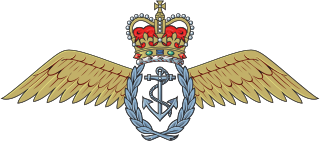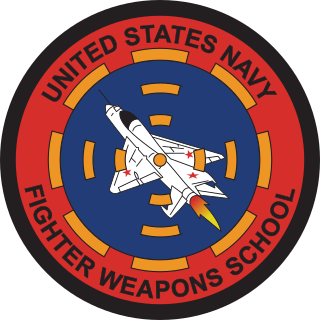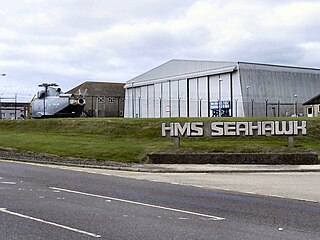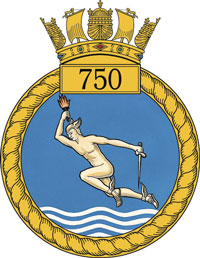
The Fleet Air Arm (FAA) is the naval aviation component of the United Kingdom's Royal Navy (RN). The FAA is one of five RN fighting arms. As of 2023 it is a predominantly "rotary" force, with helicopters undertaking roles once performed by biplanes such as the Fairey Swordfish. It operates the F-35 Lightning II for maritime strike and the AW159 Wildcat and AW101 Merlin for commando and anti-submarine warfare.

The Royal Naval Air Service (RNAS) was the air arm of the Royal Navy, under the direction of the Admiralty's Air Department, and existed formally from 1 July 1914 to 1 April 1918, when it was merged with the British Army's Royal Flying Corps to form the Royal Air Force (RAF), the world's first independent air force.

Naval aviation is the application of military air power by navies, whether from warships that embark aircraft, or land bases.

The United States Navy Strike Fighter Tactics Instructor program, more popularly known as Top Gun, is a United States Navy training program that teaches air combat maneuvering tactics and techniques to selected naval aviators and naval flight officers, who return to their operating units as surrogate instructors.

Marine Corps Air Station Miramar, formerly Naval Auxiliary Air Station (NAAS) Miramar and Naval Air Station (NAS) Miramar, is a United States Marine Corps installation that is home to the 3rd Marine Aircraft Wing, which is the aviation element of the 1st Marine Expeditionary Force. It is located in Miramar, San Diego, California, about 14 miles (23 km) north of Downtown San Diego.
A naval flight officer (NFO) is a commissioned officer in the United States Navy or United States Marine Corps who specializes in airborne weapons and sensor systems. NFOs are not pilots (naval aviators), but they may perform many "co-pilot" or "mission specialist" functions, depending on the type of aircraft. Until 1966, their duties were performed by both commissioned officer and senior enlisted naval aviation observers (NAO).

William Patrick "Willy Irish" Driscoll is a retired commander in the United States Navy and a highly decorated flying ace.

The Naval Aviation Warfighting Development Center was formerly known as the Naval Strike and Air Warfare Center at Naval Air Station Fallon located in the city of Fallon in western Nevada. It is the center of excellence for naval aviation training and tactics development. NAWDC provides service to aircrews, squadrons and air wings throughout the United States Navy through flight training, academic instructional classes, and direct operational and intelligence support. The name was changed from NSAWC to NAWDC in June 2015 to align with the naming convention of the Navy's other Warfighting Development Centers (including Naval Surface and Mine Warfighting Development Center, Naval Information Warfighting Development Center, and the Undersea Warfighting Development Center.

Royal Naval Air Station Culdrose is a Royal Navy airbase near Helston on the Lizard Peninsula of Cornwall UK, and is one of the largest helicopter bases in Europe. Its main role is serving the Fleet Air Arm's front line AgustaWestland Merlin helicopter squadrons.

The Royal Navy Observer School grew out of HM Naval Seaplane Training School at RNAS Lee-on-Solent as a result of a series of changes of identity and parent unit. From 1918 until 1939 the Royal Air Force was responsible for naval aviation, including training and provision of aircrew to the Royal Navy. With the return of naval aviation to the Royal Navy on 24 May 1939, the Observer School was established as 750 Naval Air Squadron of the Fleet Air Arm. During World War II the squadron moved to Trinidad to continue training aircrew. It was temporarily disbanded in October 1945. The squadron reformed in 1952 and is currently based at RNAS Culdrose, where it trains approximately 30 Royal Navy observers every year.

809 Naval Air Squadron, nicknamed the Immortals, is a squadron of the Fleet Air Arm of the United Kingdom. It was first formed in 1941 and flew in the Soviet Union, the Mediterranean and the Far East during the Second World War. After active service during the Suez Crisis, 809 was disbanded in 1959. Reformed in 1963 to fly Blackburn Buccaneers, the squadron was disbanded briefly in 1965–66, and then again in 1978. A brief period during the Falklands War saw 809 reformed to bring Sea Harrier FRS.1 aircraft south to the UK task group and to fly from HMS Illustrious.

736 Naval Air Squadron was a Naval Air Squadron of the Royal Navy's Fleet Air Arm. It was most recently recommissioned at HMS Seahawk, RNAS Culdrose in June 2013 to fly the BAE Systems Hawk, mainly in the maritime aggressor role, following the disbandment of the Fleet Requirements and Aircraft Direction Unit (FRADU) and operated up until March 2022. It initially formed as the School of Air Combat in May 1943 at HMS Heron, RNAS Yeovilton. In September 1943 it moved to HMS Vulture, RNAS St Merryn, where it became the Fighter Combat School and it created an independent 'B' Flight for fighter affiliation work between March and September 1945. 736 Naval Air Squadron moved to HMS Seahawk, RNAS Culdrose in February 1950 as the Naval Air Fighter School in the 52nd Training Air Group, but disbanded in August 1952. Immediately the following day, the squadron reformed at HMS Seahawk, RNAS Culdrose out of 702 Naval Air Squadron as an Advanced Jet Flying School and in November 1953 it moved to HMS Fulmar, RNAS Lossiemouth. 736 Naval Air Squadron disbanded there in March 1965, but what was left became 764 Naval Air Squadron ‘B’ Flight. The squadron reformed the same day at Lossiemouth from 809 Naval Air Squadron as a Jet Strike Training Squadron. 1966. In March 1967, its aircraft were part of the group that bombed and set on fire the supertanker SS Torrey Canyon aground and leaking crude oil on Seven Sisters rocks off Cornwall. The squadron disbanded in February 1972.
Commander Charles Bentall Lamb DSO DSC Royal Navy (1914–1981) was an officer in the Fleet Air Arm during World War II. He piloted a Fairey Swordfish torpedo strike reconnaissance aircraft at the Battle of Taranto, and later wrote a best selling book on his experiences called To War in a Stringbag.

738 Naval Air Squadron was a Naval Air Squadron of the Royal Navy's Fleet Air Arm (FAA), which last disbanded during May 1970 at HMS Goldcrest, RNAS Brawdy. It initially formed as a Pilot Training Squadron formed at HMS Asbury, RNAS Quonset Point, Rhode Island, in February 1943. The squadron moved to RNAS Lewiston, Maine, United States, at the end of July 1943 and also providing advanced carrier training to American-trained Royal Naval Volunteer Reserve (RNVR) pilots and it later provided complete Torpedo Bomber Reconnaissance (TBR) aircrew for Grumman Avenger FAA squadrons. The squadron moved to RNAS Brunswick, Maine, in February 1945 and disbanded there in July 1945. 738 Naval Air Squadron was next active as part of the Naval Air Fighter School, between May 1950 and March 1954, providing newly qualified FAA pilots the operational techniques of air-to-air and air-to-ground firing. It had formed at HMS Seahawk, RNAS Culdrose, Cornwall, England, moving to HMS Fulmar, RNAS Lossiemouth in 1953. It reformed in April 1954 at HMS Fulmar and now the squadron’s role was to instruct United States trained pilots on the British method and was also responsible for converting the FAA piston-engined pilots onto jet aircraft. It became an Advanced Flying Training Squadron in June 1962 providing training for low-level navigation, ground attack and air-to-air weapons training.

764 Naval Air Squadron was a Naval Air Squadron of the Royal Navy's Fleet Air Arm. It initially formed in April 1940, at HMS Daedalus, RNAS Lee-on-Solent, as an Advance Seaplane Training Squadron. The Squadron moved to RAF Pembroke Dock in July 1940, and later to HMS Daedalus II, RNAS Lawrenny Ferry in October 1941 and remaining there until the Squadron disbanded in November 1943. It reformed at HMS Siskin, RNAS Gosport, in February 1944, as the User Trials Unit, however, the squadron was decommissioned for the second time in September 1945. 764 Naval Air Squadron reformed again, at HMS Fulmar, RNAS Lossiemouth, in May 1953, where it became an Advanced Training Unit. It moved to HMS Heron, RNAS Yeovilton, in September 1953, where it received its first jet aircraft. In November 1954 the Squadron disbanded.

796 Naval Air Squadron was a Naval Air Squadron of the Royal Navy's Fleet Air Arm which last disbanded at RNAS Culdrose in October 1958. 796 Naval Air Squadron formed as the Eastern Fleet Torpedo Bomber Reconnaissance Pool, at RN Air Section Port Reitz, in Mombasa, in July 1942, it provided a detachment embarked in HMS Illustrious in August to support the invasion of Madagascar. This Flight also disembarked to Majunga in September to join 207 Group of the Royal Air Force and later rejoined the squadron at RNAS Tanga, in November and added operational training unit to its roles until disbanding in April 1944. It reformed in November 1947 at HMS Vulture, RNAS St Merryn, as the Aircrewman Training School, for conversion of T.A.G.'s to aircrewman standard. Its task changed to Observer School Part II in January 1950. The squadron moved to HMS Seahawk, RNAS Culdrose, in November 1953 and in 1957 took on the task of the disbanded 765 Naval Air Squadron.
Brigadier General Richard Stanley 'Dick' Lord from Johannesburg, South Africa was a South African Air Force and Royal Navy Fleet Air Arm pilot.
Dan Pedersen is a retired United States Navy Captain, credited as being the leading force behind the creation of the United States Navy Fighter Weapons School program known as “TOPGUN”.

The United States Navy's Carrier Airborne Early Warning Weapons School, more popularly known as CAEWWS, is an American military unit that develops and teaches E-2D and E-2C Hawkeye tactics, techniques, and procedures (TTP) to selected Naval Aviators and Naval Flight Officers. CAEWWS originated in the early 1980s as the tactics department of VAW-110 on Naval Air Station Miramar, California, but later commissioned on 13 July 1988 as an independent command. Today CAEWWS is incorporated into the Naval Aviation Warfighting Development Center (NAWDC) as the command and control (C2) weapons school along with the Navy Strike Fighter Weapons School (TOPGUN), Airborne Electromagnetic Attack Weapons School (HAVOC), Navy Rotary Wing Weapons School (SEAWOLF), Maritime Intelligence Surveillance Reconnaissance Weapons School (MISR), and STRIKE.
Commander Jeremy John Ovens QCVS is a former Royal Navy officer and executive officer.















